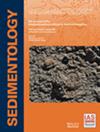纳米比亚新元古代Zerrissene群大型富砂海底扇系叶状相空间分布与变异性
IF 2.8
2区 地球科学
Q1 GEOLOGY
引用次数: 0
摘要
纳米比亚中西部上新元古代Zerrissene群的沉积代表了一个大型的硅屑深水沉积体系,展示了从床级到扇级体系规模的复杂相和建筑关系。纳米布沙漠缺乏植被,褶皱地层有规律的东西重复(反映约50%的构造缩短),在目前约2700平方公里的面积上提供了准三维暴露。布拉克河组是Zerrissene群的中间富砂单元,由近600米的地层组成,暴露在多个平行连续的露头中,最长可达10公里,并斜向沉积倾角。10个地层剖面在整个盆地上进行了32公里(恢复了64公里)的对比,并提供了与现代海底扇相当规模的暴露。确定了6种沉积相,并将其分为4种相组合,代表了无约束海底扇系统中深水叶片的轴向至边缘部分。空间相格局、区域厚度变化和古洋流表明,布拉克河组沉积物主要通过槽状盆地从北向南西输送,并沉积在Adamastor和Khomas海洋交界的无约束盆地平原上。独特的露头暴露和范围允许记录布拉克河海底扇系统的系统规模结构和盆地配置。从富砂的布拉克河组下游到布拉克河组中上游以泥岩为主的夹层过渡,记录了叶状沉积从沉积到补偿堆积的变化。这记录了一个大型海底扇的演变,因为它充满了微妙的海底地形,并在系统尺度上变得不那么受限制。从厘米尺度到盆地尺度对这些深水沉积物的记录为富砂沉积物重力流向海底裂片的广泛长距离输送提供了一个新的模型,而没有明显的河道化。本文章由计算机程序翻译,如有差异,请以英文原文为准。
Spatial distribution and variability of lobe facies in a large sand‐rich submarine fan system: Neoproterozoic Zerrissene Group, Namibia
The deposits of the upper Neoproterozoic Zerrissene Group of central‐western Namibia represent a large siliciclastic deep‐water depositional system that showcases the intricacies of facies and architectural relationships from bed‐scale to fan‐system‐scale. The lack of vegetation in the Namib Desert and regular east–west repetition of folded stratigraphy (reflecting ca 50% tectonic shortening) provides quasi‐three‐dimensional exposure over a current area of approximately 2700 square kilometres. The Brak River Formation, the middle sand‐rich unit of the Zerrissene Group, consists of nearly 600 m of strata exposed in multiple parallel continuous outcrops up to ca 10 km in length and oriented obliquely to depositional dip. Ten stratigraphic sections are correlated ca 32 km (ca 64 km restored) across the basin and offer exposure comparable in scale to modern submarine fans. Six sedimentary facies are identified and grouped into four facies associations that represent axial‐to‐marginal portions of deep‐water lobes in an unconfined submarine fan system. Spatial facies patterns, regional thickness variations, and palaeocurrents indicate that Brak River Formation sediments were transported primarily from the north to south–south‐west through a trough‐like basin and deposited within an unconfined basin plain at the junction of the Adamastor and Khomas oceans. The unique outcrop exposure and extent permits the documentation of system‐scale architecture and basin configuration of the Brak River submarine fan system. A transition from the sand‐rich lower Brak River Formation to more intercalated mudstone‐dominated intervals in the middle and upper Brak River Formation is interpreted to record a change from aggradational to compensational stacking of lobe deposits. This records the evolution of a large submarine fan as it filled the subtle seafloor topography and became less confined at the system‐scale. The documentation of these deep‐water deposits from centimetre‐scale to basin‐scale provides a new model for a system with extensive long‐distance transport of sand‐rich sediment gravity flows to submarine lobes without apparent channelization.
求助全文
通过发布文献求助,成功后即可免费获取论文全文。
去求助
来源期刊

Sedimentology
地学-地质学
CiteScore
8.20
自引率
11.40%
发文量
94
审稿时长
6-12 weeks
期刊介绍:
The international leader in its field, Sedimentology publishes ground-breaking research from across the spectrum of sedimentology, sedimentary geology and sedimentary geochemistry.
Areas covered include: experimental and theoretical grain transport; sediment fluxes; modern and ancient sedimentary environments; sequence stratigraphy sediment-organism interaction; palaeosoils; diagenesis; stable isotope geochemistry; environmental sedimentology
 求助内容:
求助内容: 应助结果提醒方式:
应助结果提醒方式:


